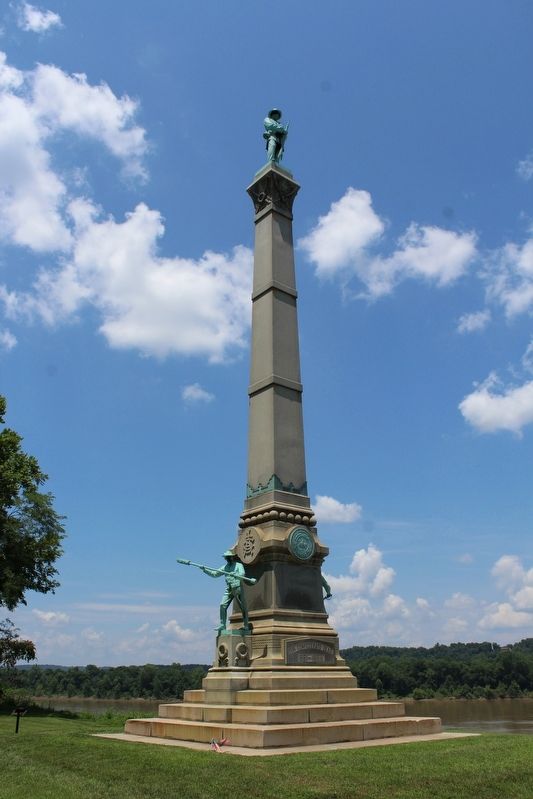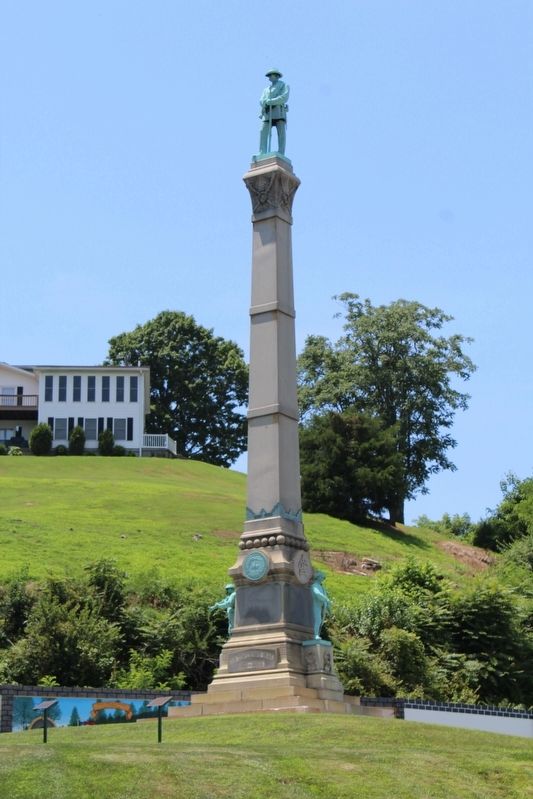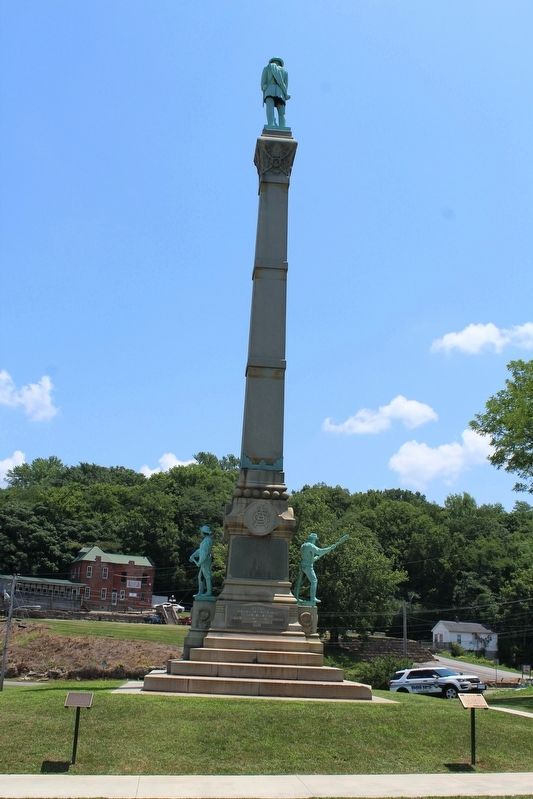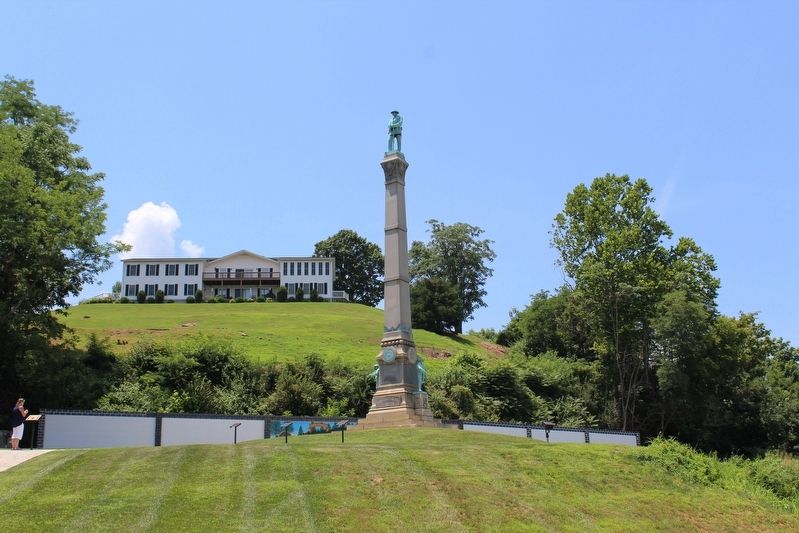Brandenburg in Meade County, Kentucky — The American South (East South Central)
Louisville, Kentucky Confederate Monument
1861-1865
Tribute
to the Rank and File of the
Armies of the South
by the Kentucky Women's Confederate
Monument Association.
1895
Erected 1895 by The Kentucky Women's Confederate Monument Association.
Topics. This monument and memorial is listed in this topic list: War, US Civil.
Location. 38° 0.293′ N, 86° 10.184′ W. Marker is in Brandenburg, Kentucky, in Meade County. Memorial can be reached from the intersection of Main Street and Water Street, on the left when traveling north. Touch for map. Marker is in this post office area: Brandenburg KY 40108, United States of America. Touch for directions.
Other nearby markers. At least 8 other markers are within walking distance of this marker. Morgan — On To Ohio (within shouting distance of this marker); Meade County Monument (within shouting distance of this marker); Early Meade County Leader / Meade County Courthouse (within shouting distance of this marker); Flint for the Hunt (about 700 feet away, measured in a direct line); Underground Railroad Statue (about 800 feet away); A Rest at Otter Creek (approx. 0.2 miles away); Capture of the Alice Dean (approx. 0.2 miles away); Morgan's Headquarters (approx. 0.2 miles away). Touch for a list and map of all markers in Brandenburg.
Also see . . . Confederate Monument in Louisville. Wikipedia (Submitted on November 13, 2018.)
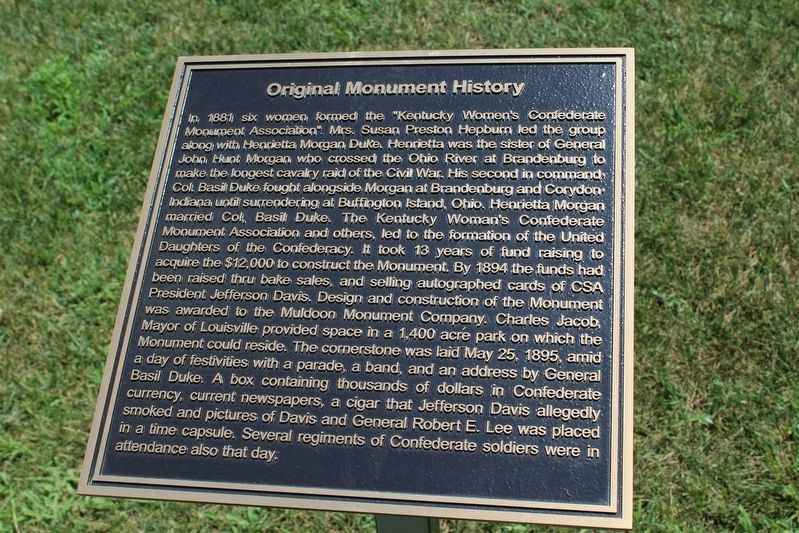
Photographed By Tom Bosse, July 5, 2018
5. Original Monument History
In 1881 six women formed the “Kentucky Women’s Confederate Monument Association”. Mrs. Susan Preston Hepburn led the group along with Henrietta Morgan Duke. Henrietta was the sister of General John Hunt Morgan who crossed the Ohio River at Brandenburg to make the longest cavalry raid of the Civil War. His second in command, Col. Basil Duke fought alongside Morgan at Brandenburg and Corydon, Indiana until surrendering at Buffington Island, Ohio. Henrietta Morgan married Col. Basil Duke. The Kentucky Woman’s Confederate Monument Association and others, led to the formation of the United Daughters of the Confederacy. It took 13 years of fund raising to acquire the $12,000 to construct the Monument. By 1894, the funds had been raised thru bake sales, and selling autographed cards of CSA President Jefferson Davis. Design and construction of the Monument was awarded to the Muldoon Monument Company. Charles Jacob, Mayor of Louisville provided space in a 1,400 acre park on which the Monument could reside. The cornerstone was laid May 25, 1895, amid a day of festivities with a parade, a band, and an address by General Basil Duke. A box containing thousands of dollars in Confederate currency, current newspapers, a cigar that Jefferson David allegedly smoked and pictures of Davis and General Robert E. Lee was placed in a time capsule. Several regiments of Confederate soldiers were in attendance also that day.
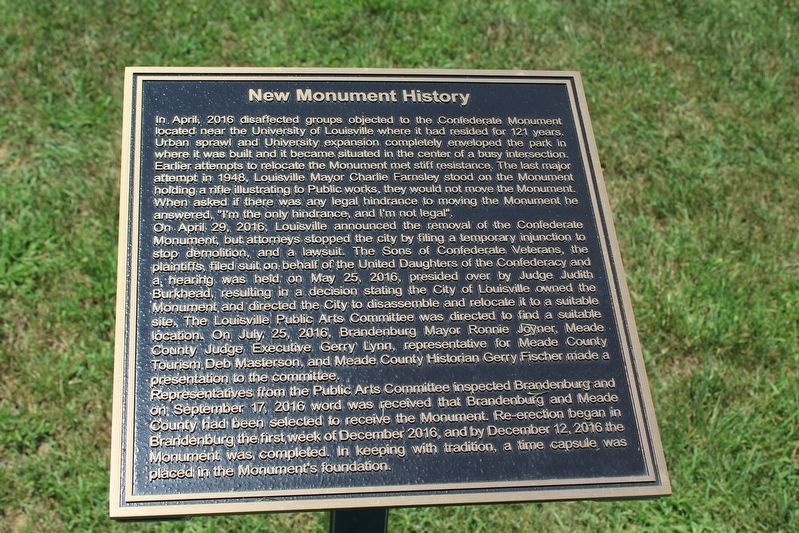
Photographed By Tom Bosse, July 5, 2018
6. New Monument History
In April, 2016 disaffected groups objected to the Confederate Monument located near the University of Louisville where it had resided for 121 years. Urban sprawl and University expansion completely enveloped the park in where it was built and it became situated in the center of a busy intersection. Earlier attempts to relocate the Monument met stiff resistance. The last major attempt in 1948, Louisville Mayor Charlie Farnsley stood on the Monument holding a rifle illustrating to Public works, they would not move the Monument. When asked if there was any legal hindrance to moving the Monument he answered, “I’m the only hindrance, and I’m not legal”.
On April 29, 2016, Louisville announced the removal of the Confederate Monument, but attorneys stopped the city by filing a temporary injunction to stop demolition, and a lawsuit. The Sons of Confederate Veterans, the plaintiffs, filed suit on behalf of the United Daughters of the Confederacy and a hearing was held on May 25, 2016, presided over by Judge Judith Burkhead, resulting in a decision stating the City of Louisville owned the Monument and directed the City to disassemble and relocate it to a suitable site. The Louisville Public Arts Committee was directed to find a suitable location. On July 25, 2016, Brandenburg Mayor Ronnie Joyner, Meade County Judge Executive Gerry Lynn, representative for Meade County Tourism Deb Masterson, and Meade County Historian Gerry Fischer made a presentation to the committee.
Representatives from the Public Arts Committee inspected Brandenburg and on September 17, 2016 word was received that Brandenburg and Meade County had been selected to receive the Monument. Re-erection began in Brandenburg the first week of December 2016, and by December 12, 2016 the Monument was completed. In keeping with tradition, a time capsule was placed in the Monument’s foundation.
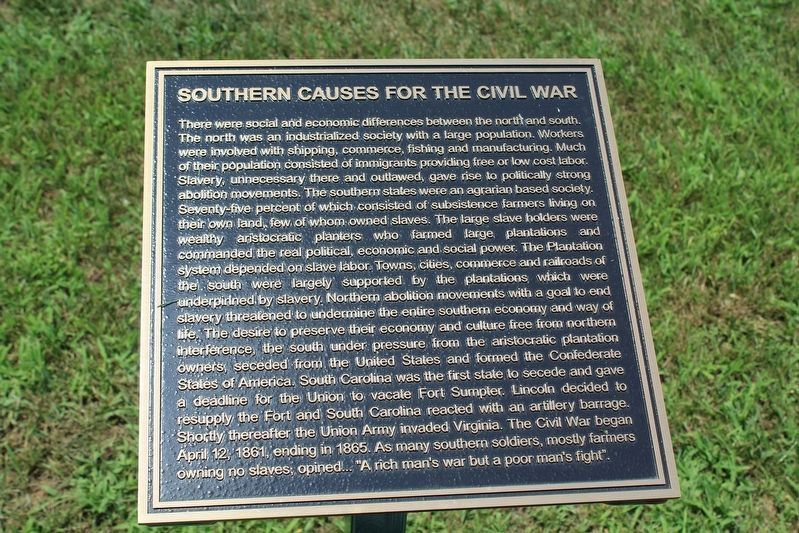
Photographed By Tom Bosse, July 5, 2018
7. Southern Causes for the Civil War
There were social and economic differences between the north and south. The north was an industrialized society with a large population. Workers were involved with shipping, commerce, fishing and manufacturing. Much of their population consisted of immigrants providing free or low-cost labor. Slavery, unnecessary there and outlawed, gave rise to politically strong abolition movements. The southern states were an agrarian based society. Seventy-five percent of which consisted of subsistence farmers living on their own land, few of whom owned slaves. The large slave holders were wealthy aristocratic planters who farmed large plantations and commanded the real political, economic and social power. The Plantation system depended on slave labor. Towns, cities commerce and railroads of the south were largely supported by the plantations which were underpinned by slavery. Northern abolition movements with a goal to end slavery threatened to undermine the entire southern economy and way of life. The desire to preserve their economy and culture free from northern interference, the south under pressure from the aristocratic plantation owners, seceded from the United States and formed the Confederate States of America. South Carolina was the first state to secede and gave a deadline for the Union to vacate Fort Sumpter. Lincoln decided to resupply the Fort and South Carolina reacted with an artillery barrage. Shortly thereafter the Union Army invaded Virginia. The Civil war began April 12, 1861, ending in 1865. As many southern soldiers, mostly farmers owning no slaves, opined… “A rich man’s war but a poor man’s fight”.
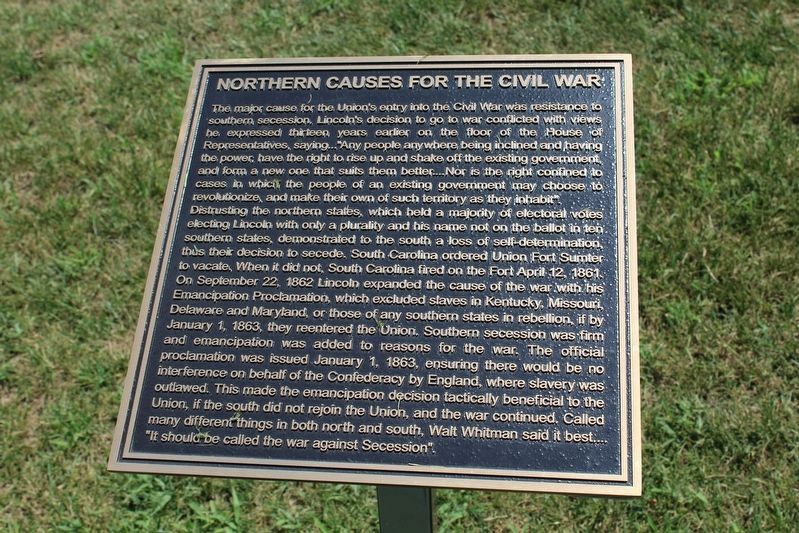
Photographed By Tom Bosse, July 5, 2018
8. Northern Causes for the Civil War
The major cause for the Union’s entry in the Civil War was resistance to southern secession. Lincoln’s desire to go to war conflicted with views he expressed thirteen years earlier on the floor of the House of Representatives, saying… “Any people anywhere being inclined and having the power, have the right to rise up and shake off the existing government, and form a new one that suits them better…Nor is the right confined to cases in which the people of an existing government may choose to revolutionize, and make their own of such territory as they inhabit.” Distrusting the northern states, which held a majority of electoral votes electing Lincoln with only a plurality and his name not on the ballot in ten southern states, demonstrated to the south a loss of self-determination, thus their decision to secede. South Carolina ordered Union Fort Sumpter to vacate. When it did not, South Carolina fired o the Fort April 12, 1861. On September 22, 1862 Lincoln expanded the cause of the war with his Emancipation Proclamation, which excluded slaves in Kentucky, Missouri, Delaware and Maryland, or those of any southern states in rebellion, if by January 1, 1863, they reentered the Union. Southern secession was firm and emancipation was added to reasons for the war. The official proclamation was issued January 1, 1863, ensuring there would be no interference on behalf of the Confederacy by England, where slavery was outlawed. This made the emancipation decision tactically beneficial to the Union, if the south did not rejoin the Union, and the war continued. Called many different things in both north and south, Walt Whitman said it best… “It should be called the war against Secession.”
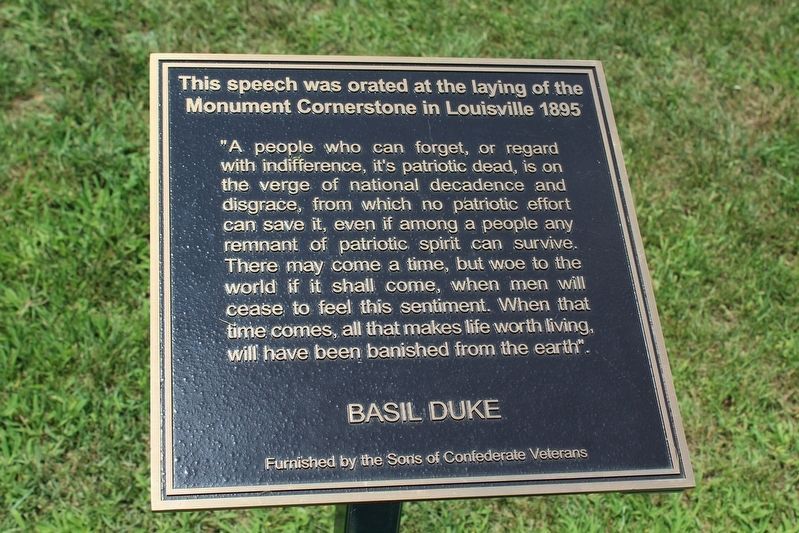
Photographed By Tom Bosse, July 5, 2018
9. Basil Duke Quote
This speech was orated at the laying of the Monument Cornerstone in Louisville 1895
“A people who can forget, or regard with indifference, it’s patriotic idea, is on the verge of national decadence and disgrace, from which no patriotic effort can save it, even if among a people any remnant of patriotic spirit can survive. There may come a time, but woe to the world if it shall come, when men will cease to feel this sentiment. When that time comes, all that makes life worth living, will have been banished from the earth.” Basil Duke. Furnished by the Sons of Confederate Veterans.
Credits. This page was last revised on December 3, 2018. It was originally submitted on November 12, 2018, by Tom Bosse of Jefferson City, Tennessee. This page has been viewed 457 times since then and 34 times this year. Photos: 1, 2, 3, 4, 5, 6. submitted on November 12, 2018, by Tom Bosse of Jefferson City, Tennessee. 7, 8, 9. submitted on November 13, 2018, by Tom Bosse of Jefferson City, Tennessee. • Bernard Fisher was the editor who published this page.
